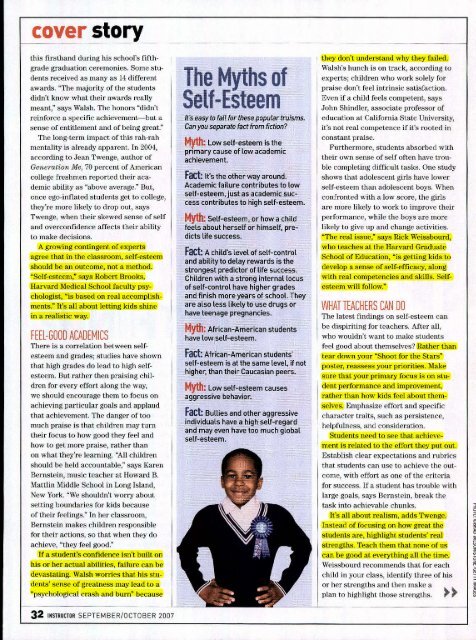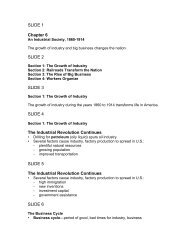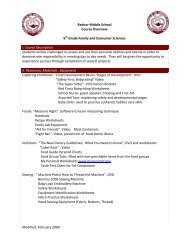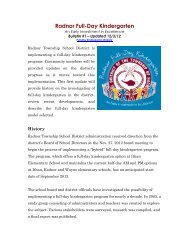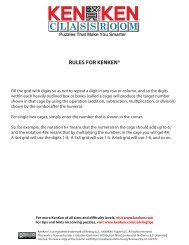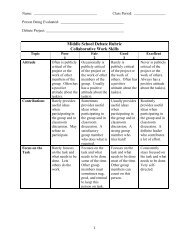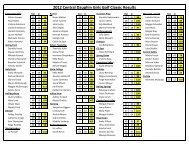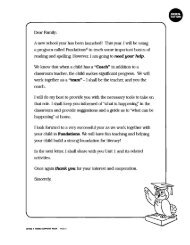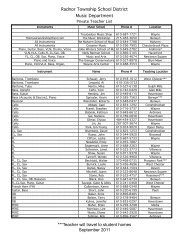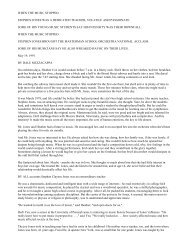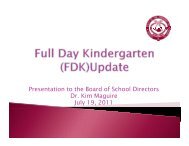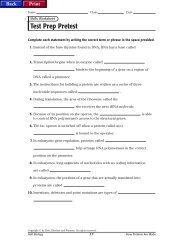Self-Esteem and Student Achievement
Self-Esteem and Student Achievement
Self-Esteem and Student Achievement
Create successful ePaper yourself
Turn your PDF publications into a flip-book with our unique Google optimized e-Paper software.
cover storythis firsth<strong>and</strong> during his school's fifthgradegraduation ceremonies. Some studentsreceived as many as 14 differentawards. "The majority of the studentsdidn't know what their awards reallymeant," says Walsh. The honors "didn'treinforce a specific achievement-but asense of entitlement <strong>and</strong> of being great."The long-term impact of this rah-rahmentality is already apparent. In 2004,according to Jean Twenge, author ofGeneration Me, 70 percent of Americancollege freshmen reported their academicability as "above average." But,once ego-inflated students get to college,they're more likely to drop out, saysTwenge, when their skewed sense of self<strong>and</strong> overconfidence affects their abilityto make decisions.A growing contingent of expertsagree that in the classroom, self-esteemshould be an outcome, not a method."<strong>Self</strong>-esteem," says Robert Brooks,Harvard Medical School faculty psychologist,"is based on real accomplishments."It's all about letting kids shinein a realistic way.FEEL-GOOD ACADEMICSThere is a correlation between selfesteem<strong>and</strong> grades; studies have shownthat high grades do lead to high selfesteem.But rather then praising childrenfor every effort along the way,we should encourage them to focus onachieving particular goals <strong>and</strong> applaudthat achievement. The danger of toomuch praise is that children may turntheir focus to how good they feel <strong>and</strong>how to get more praise, rather thanon what they're learning. "All childrenshould be held accountable," says KarenBernstein, music teacher at Howard B.Mattlin Middle School in Long Isl<strong>and</strong>,New York. "We shouldn't worry aboutsetting boundaries for kids becauseof their feelings." In her classroom,Bernstein makes children responsiblefor their actions, so that when they doachieve, "they feel good."If a student's confidence isn't built onhis or her actual abilities, failure can bedevastating. Walsh worries that his students'sense of greatness may lead to a"psychological crash <strong>and</strong> burn" becauseThe Myths of<strong>Self</strong>-<strong>Esteem</strong>It's easy to fall for these poputar truisms.Can you separate fact from fiction?they don't underst<strong>and</strong> why they failed.Walsh's hunch is on track, according toexperts; children who work solely forpraise don't feel intrinsic satisfaction.Even if a child feels competent, saysJohn Shindler, associate professor ofeducation at California State University,it's not real competence if it's rooted inconstant praise.Furthermore, students absorbed withtheir own sense of self often have troublecompleting difficult tasks. One studyshows that adolescent girls have lowerself-esteem than adolescent boys. Whenconfronted with a low score, the girlsare more likely to work to improve theirperformance, while the boys are morelikely to give up <strong>and</strong> change activities."The real issue," says Rick Weissbourd,who teaches at the Harvard GraduateSchool of Education, "is getting kids todevelop a sense of self-efficacy, alongwith real competencies <strong>and</strong> skills. <strong>Self</strong>esteemwill follow."WHAT TEACHERS CAN DOThe latest findings on self-esteem canbe dispiriting for teachers. After all,who wouldn't want to make studentsfeel good about themselves? Rather thantear down your "Shoot for the Stars"poster, reassess your priorities. Makesure that your primary focus is on studentperformance <strong>and</strong> improvement,rather than how kids feel about themselves.Emphasize effort <strong>and</strong> specificcharacter traits, such as persistence,helpfulness, <strong>and</strong> consideration.<strong>Student</strong>s need to see that achievementis related to the effort they put out.Establish clear expectations <strong>and</strong> rubricsthat students can use to achieve the outcome,with effort as one of the criteriafor success. If a student has trouble withlarge goals, says Bernstein, break thetask into achievable chunks.It's all about realism, adds Twenge.Instead of focusing on how great thestudents are, highlight students' realstrengths. Teach them that none of uscan be good at everything all the time.Weissbourd recommends that for eachchild in your class, identify three of hisor her strengths <strong>and</strong> then make aplan to highlight those strengths.32 INSTRUCTOR SEPTEMBER/OCTOBER 2007


